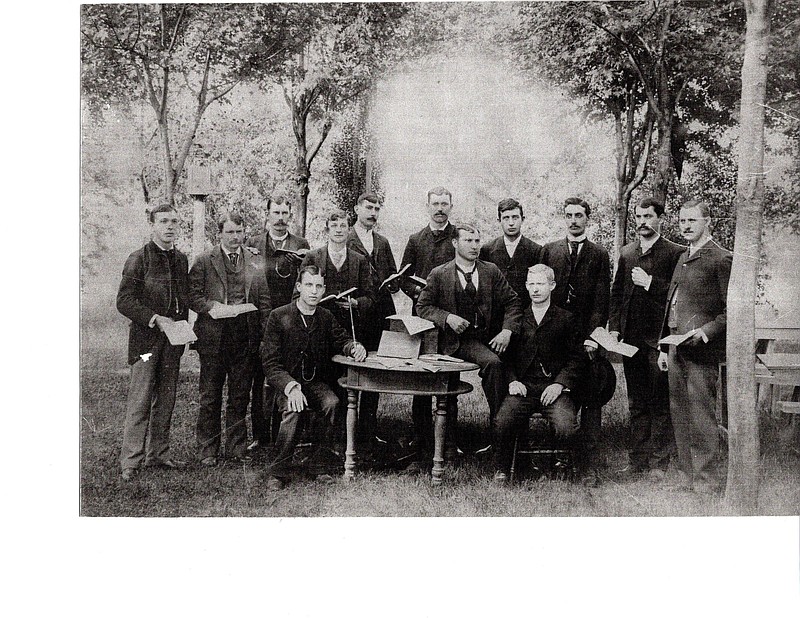Jefferson City had no city parks in the 19th century and early years of the 20th. Only the Capitol grounds, called Capitol Park, served residents as a public park. In 1895, the state placed iron-frame, wooden-seat "settees" along sidewalks to accommodate the many strollers.
Newspapers from 1870-1920 reveal a cavalcade of private sites that served residents in lieu of city parks where residents and groups could picnic, relax, forget life's cares and "wash away the dust of daily living." Names include Altgiber's Garden, Walther's Grove, Dwight's Pasture, "behind Shackleford's house on Woodcrest" and "along Wear's Creek" in today's Washington Park. Segregated Black people picnicked and had emancipation celebrations on open land on Lafayette Street or along Wear's Creek.
The best-known private place before city parks was Cottage Place Park on East McCarty Street at Lafayette Street. It was used for citywide Fourth of July celebrations and the Flower Parades. It had a grandstand and track for large events like horse shows. Other private places were Binder's Park on West Main Street, which became Memorial Park in the 1940s, and beer gardens such as Gundelfinger's on West Main Street, Franz's on Bolivar Street (later the site of St. Mary's Hospital), and Friemel's on Madison Street.
By far the most popular place for common folk to party at all times of the year was Friemel's Beer Garden in the heart of the city in the 600 block of Madison Street, opposite present Central Dairy. Ernst Friemel, a Silesian Prussian immigrant, opened a High Street saloon in 1876 and organized a six-piece music group, Friemel's Band or Musik Korps. In 1881, Friemel took over the abandoned property of the Turner Garden on Madison Street and turned it into Friemel's Garden. It became the "place to go" where "one could relax after the heat of the day in homey circles of friends and families." Civic groups, like the volunteer firemen, the police and labor unions, as well as many church groups held holiday festivities and picnics on its shady slopes. Friemel built his residence there in 1883 and a separate entertainment hall with mansard roof. Friemel sold local beer, wine, and sandwiches of meat and cheese, but the public could also bring their own food and drink. Friemel could not be both an orchestra leader and full-time beer garden operator, so his band dissolved and other orchestral groups of the many in the city entertained the partiers on the breezy, shady hilltop. St. Peter's Orchestra performed for many Labor Day events and for weekly dances as late as 1915. Apparently, Friemel earned sufficient income from sale of food and drink, because newspapers record only one mention of a charge for a Labor Day event, with ladies free.
Friemel died in 1913 after 32 years operating his very popular garden. His widow kept the garden going for three years until her death in 1916, by which time troubles attendant on World War I, agitation for prohibition and the emergence of other partying venues signaled the end of Friemel's Garden. The property had also become highly developable for other purposes in a fast-growing Southside. The last advertised public event, a masked ball, was held in Friemel's Garden in 1917. Similarly, the smaller Franz's Beer Garden on Bolivar Street, already largely unused, had earlier passed out of existence when the Moerschel family, owners, donated the land in 1902 for St. Mary's Hospital.
The Jefferson City 1921 city directory still did not list a city park, but it names four private parks: Electric Park, 914 W. Main St.; Houchin's Driving Park, 1400 E. Dunklin St.; Ruwart's Baseball Park, 901 Lafayette St. (on the Lincoln University campus); and Idylour (Moreau) Park on Moreau Drive, 1 mile south of city limits.
City parks eventually came to Jefferson City after World War I. Judge Arthur M. Hough donated land to the city for Hough Park in 1917, but it lay undeveloped outside the city and mostly unused as a park until the late 1930s. It became Hough Park Golf Course, currently Oak Hills Golf Course. McClung State Park was created in 1915 where inmates of the Missouri State Penitentiary had quarried stone. It continued as a state park, slightly developed, until 1940 when the city bought the 45-acre tract to make it truly a city park.
Residents and groups had been using the vacant low ground along Wear's Creek in today's Washington Park as park space since before the turn of the 19th century. When the residential Washington Park Addition was laid out in 1912, several of its low-lying lots along the creek remained unsold. The Chamber of Commerce donated them and other land to the city in 1929 for Jefferson City's first real city park. Its name came from the existing Washington Park Addition.
City parks today are an essential contribution to the good life in Jefferson City.
Walter Schroeder grew up in Jefferson City's historic German Southside now known as Old Munichburg. A retired professor of geography, he is devoted to preserving cultural history and is the author of three books on the history of the Old Munichburg neighborhood.

